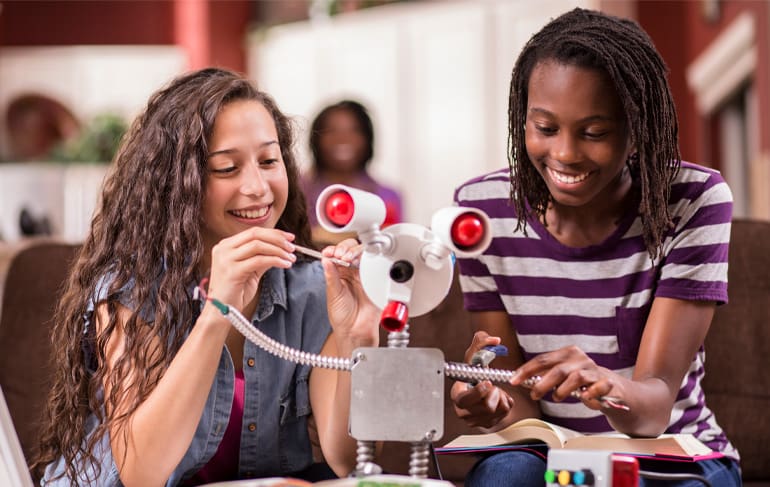In today’s tech-driven world, practical STEM education for high school students is critical. ASU Prep is at the forefront of this initiative, connecting K–12 STEM to everyday life through the Engineering Projects in Community Service (EPICS) program.
What is EPICS at ASU Prep?
Arizona State University’s Engineering Projects in Community Service (EPICS), is an award-winning social entrepreneurship program, which has been adapted for high school students. Now being implemented as a science elective at ASU Prep Downtown and Polytechnic campuses, EPICS High engages students in hands-on STEM activities, equipping them with skills in discipline knowledge, design process, teamwork, communication, ethics, and more.
The design-based service learning program allows students to work on projects that provide solutions to real-world problems in partnership with local partners, focusing on community development, health, sustainability, and/or education. Rachna Mathur, ASU Prep STEM Strategist, is thrilled to have EPICS High at both ASU Prep Downtown and Poly to foster in students a love and curiosity for STEM. She also emphasizes the social element: “A program like this connects the dots between engineering and social entrepreneurship, which is critical in serving your communities.”
Mathur points out the many benefits of working under the guidance of the established ASU EPICS program. Structure and programming are provided, along with the unique advantage of college-level mentors. The university also provides budgetary support as student teams are required to submit their project budgets to ASU, which then provides financial backing for their projects. ASU Prep students in the program are eligible to earn college-level credit and may cross-credit their participation as internship experience.
EPICS at ASU Prep Polytechnic
At ASU Prep Poly, teacher Max Colfer is spearheading the EPICS program in both his beginning STEM class with 24 students and his advanced STEM class with 26 students. Embarking on their journey with a practice run to immerse themselves in the various stages of project development, the students experience the range of responsibilities, roles, and expectations that come with the job.
The students engaged with staff members, conducted a comprehensive needs assessment, and ventured into 3D modeling—planning, creating, printing, and painting nameplates.They also honed their professionalism and communication skills, including proper email etiquette.
Further, they utilized a large format printer to create classroom banners per teacher requests and established a Google Sites website for efficient project and stakeholder management, focusing on the importance of maintaining relationships with stakeholders post-product delivery.
Colfer is inspired as his students imagine and create solutions to improve people’s lives. He shares, “I’m extremely proud of my students. They’ve faced the rigorous EPICS program head-on and what they’ve accomplished in the last two months is nothing short of incredible.” He’s confident they’re ready to advance to the official ASU EPICS projects: “I’m really eager to see what kind of connections we can make on campus and how we can expand our educational network.”
EPICS at ASU Prep Downtown Phoenix
At ASU Prep Downtown Phoenix, teacher Julie Johnson is steering her twelve students through the intricate process of Human-Centered Engineering Design, an approach that equips engineers with the necessary technical knowledge to research and identify user needs, translate those into tangible product or process design ideas, and scientifically evaluate the usability of products or services.
The journey began with a practice run where students crafted duct tape wallets for their peers. This exercise involved needs assessment, planning, and prototype creation. They also practiced the proposal process, presenting to Ms. Johnson ideas to transform an unused downtown lot.
Students are now moving into their official projects. Focused on school improvement in collaboration with Assistant Principal Ms. Muñoz, the students are reshaping campus spaces to enhance community. This hands-on experience underscores the practical application of science and math in K–12 education, illustrating its real-world impact.
The class is divided into three groups of four, with each member assuming a distinct role—leader, partner liaison, materials manager, and budget manager. One group is tackling a media center transformation project, aiming to catalog books, develop a check-in and check-out system, and create flexible study spaces. Another team is working on a garden enhancement project, planning to plant flowers, fruits, and vegetables to harvest, as well as revamping a mural. The third group is focusing on exterior beautification, with plans to improve sports courts and fields and repaint activity areas like foursquare and hopscotch zones.
According to Johnson, a significant advantage of this program is introducing students to a variety of careers within the STEM field: “There are numerous career paths that entail problem-solving.”
Engaging and encouraging STEM passion
The EPICS High program goes beyond academics; it instills in students the importance of service and increases their interest in STEM pathways. The goal? To spark an enduring appreciation for STEM, preparing students for success in college, careers, and beyond. As such, EPICS serves as an essential tool in promoting real-world STEM learning experiences and preparing students for the future.
In designing, building, and deploying systems to solve engineering-based problems for their community, students hone their skills as engineers and social entrepreneurs. They aren’t waiting to graduate to make a difference—they’re tackling real-world problems today, preparing for STEM careers while still in high school.
Learn more
For more information about ASU Prep Polytechnic and ASU Prep Phoenix, please visit asuprep.asu.edu.

